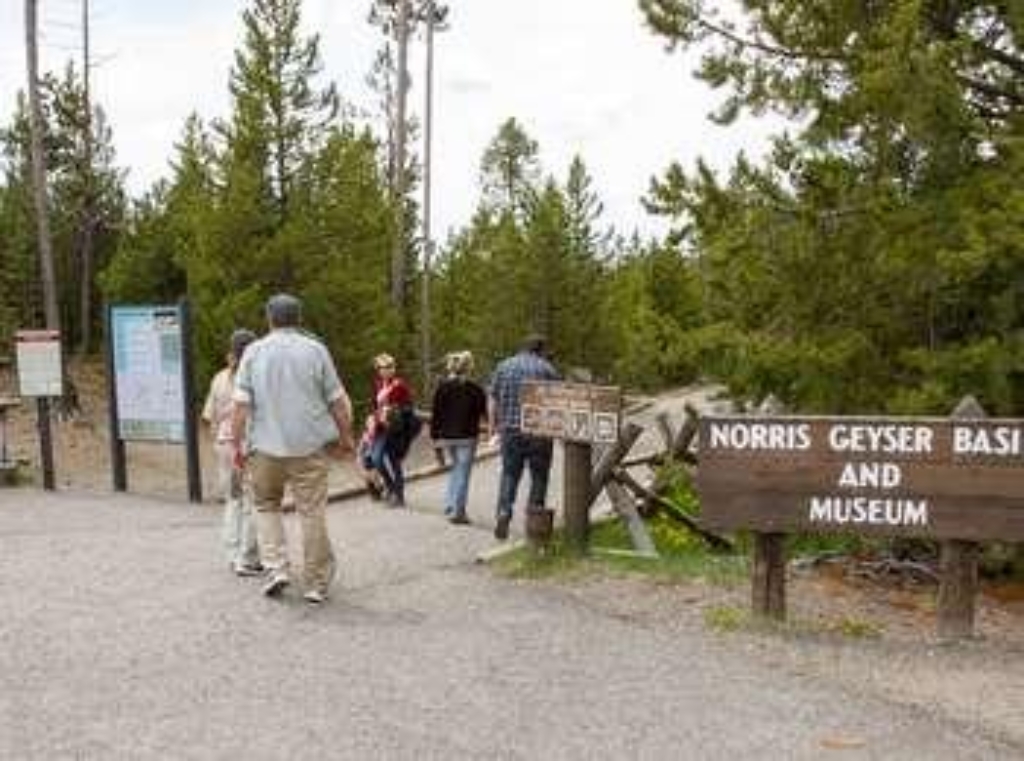
Limited parking, especially 10 am-6 pm. Park at your own risk. When Steamboat Geyser erupts, dissolved minerals in the spray can damage glass and paint on your vehicle.
Norris Geyser Basin is one of the hottest and most acidic of Yellowstone’s hydrothermal areas. It is outside of the most recent Yellowstone caldera, but inside the first and largest caldera. It sits on the intersection of three major faults and is a very active earthquake area.
Constant Change
Each year, new hot springs and geysers appear while others become dormant. Geologic events trigger many of these changes. Even small earthquakes can alter hydrothermal behavior.
Clear pools become muddy and boil violently, and some temporarily become geysers. Geysers stop erupting or have altered cycles. New features appear. This sudden activity is known as a “thermal disturbance” and can last a few days, or more than a week. Gradually, most features return to “normal.”
No one fully understands why this happens. Norris has the greatest water chemistry diversity among Yellowstone’s hydrothermal areas. The water chemistry changes as the water levels of underground hot water reservoirs fluctuates. Although Norris is known for its acid features, it also has alkaline hot springs and geysers. As underground water and chemistry shift suddenly, they could contribute to dramatic changes in minerals and pH.
Philetus Norris
Philetus W. Norris was the second superintendent of Yellowstone national Park from 1877 to 1882. He recorded the Norris Geyser Basin area’s hydrothermal features in detail and his extensive exploration added immensely to the geographic knowledge of the park.
Norris also oversaw construction of the park’s first roads, parts of which still remain as the Grand Loop Road.
Norris hired the park’s first “gamekeeper” and campaigned for legislation to help adequately protect Yellowstone against the ravages of poachers and vandals.
Color and Heat Lovers
Hydrothermal features are also habitats in which microscopic organisms survive and thrive. They are called thermophiles: "thermo" for heat and "phile" for lover.
Although they are too small to be seen with the naked eye, trillions are grouped together and appear as masses of color. They are nourished by energy and chemical building blocks.
Colorless and yellow thermophiles grow in the hottest water.
Orange, brown, and green thermophiles grow in cooler waters.
Imagine living in near-boiling temperatures, in hydrothermal features with the alkalinity of baking soda, or in water so acidic that it can burn holes in clothing. Microorganisms in Yellowstone need these extremes to survive.
Norris Geyser Basin
Norris Geyser Basin is one of the hottest and most acidic of Yellowstone’s hydrothermal areas. It is outside of the most recent Yellowstone caldera, but inside the first and largest caldera. It sits on the intersection of three major faults and is a very active earthquake area.
Each year, new hot springs and geysers appear while others become dormant. Geologic events trigger many of these changes. Even small earthquakes can alter hydrothermal behavior. This sudden activity is known as a “thermal disturbance” and can last a few days, or more than a week. Gradually, most features return to “normal.”
No one fully understands why this happens. Norris has the greatest water chemistry diversity among Yellowstone’s hydrothermal areas. The water chemistry changes as the water levels of underground hot water reservoirs fluctuates.
Although Norris is known for its acid features, it also has alkaline hot springs and geysers. As underground water and chemistry shift suddenly, they could contribute to dramatic changes in minerals and pH.
Accessibility
Visitors using wheelchairs can see the steam and colors of Porcelain Basin from the Norris Museum. Emerald Pool, Steamboat and Echinus geysers are nearby and are accessible with assistance. Wheelchair travel into Porcelain and Back basins is difficult due to stairs, steep inclines, uneven ground, and changes in trail surface. Visitors using manual wheelchairs may require assistance; motorized wheelchairs may not have enough power. Consult the area trail guide or ask a ranger to recommend routes.
Due to rough terrain, expect steep grades that exceed 8% and uneven ground where rocks and roots protrude into the trail. Most of these sections are marked on the Norris Geyser Basin Trail Guide map, but may change. Use caution.
Use Caution in Hydrothermal Areas
- Stay on boardwalks and designated trails.
- Hydrothermal water can severely burn you.
- Never run, push, or shove.
- Supervise children at all times.
- Do not scratch hydrothermal mats.
You are responsible for your safety.
Think safety, act safely. Yellowstone is a dangerous place.
Is there something we missed for this itinerary?
Itineraries across USA


















































